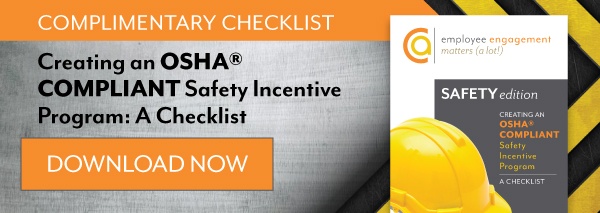Workplace safety unites the interests of employers and employees, as no one wants to see injuries or lost time from preventable incidents on the job. A properly structured Safety Incentive Program not only decreases injuries and lost time, it also works to increase productivity and overall employee satisfaction. Let’s take a closer look at the statistics behind ladder incidents in construction.
LADDER INCIDENTS IN THE CONSTRUCTION INDUSTRY
According to the CDC, more than 500,000 people face a ladder incident and about 300 people die from ladder-related injuries. These injuries can be avoided through following recommendations from the American Ladder Institute, being mindful of the ladder maximum load, watching for slippery materials, having ongoing employee safety training, and more. All in all, there are always new ways to improve your team’s ladder safety education and practices.
What Does Ladder Safety Look Like in Practice?
Before stepping foot on a ladder, your construction employees need to have an understanding of safe ladder practices. When utilizing a ladder for a workplace project, ask your employees to perform a quick evaluation of their environment, including the height of the project space, what supplies will be needed to complete their task, and if they are wearing the right equipment to climb a ladder. Once this assessment is completed, they're safe to proceed with careful caution, total awareness of their surroundings, and level-headedness.
6 TIPS FOR LADDER SAFETY IN THE WORKPLACE
In addition to this, there are a few more things your crews need to look out for to climb a ladder safely. The following are six helpful hints that employees should consider before or while using a ladder:
-
Check Where You are Stepping
Check your shoes to make sure they are free of mud, grease, oil, or any elements that may cause you to slip. Further, be sure that the soles of your shoes are free of debris, such as nails and screws. (Remember NO leather soles!)
-
Look Out for Ladder Defects
Another thing to inspect is ladder defects. Take a look at the side rails for flaws and cracks, and promptly report and address any defects.
-
Ensure the Ladder is the Right Size
Next, you need to make sure that the ladder you are using is the right size for the job at hand. Here are some things to note:
- The duty rating of the ladder must be greater than the total weight of the climber on the ladder.
- The length of the ladder must be tall enough so that the climber doesn’t have to reach for objects.
If you need help choosing the right ladder, check out this resource from the American Ladder Institute: Choosing the Right Ladder
-
Make Sure the Ladder is on Firm, Level Ground
You want to avoid placing your ladders on uneven surfaces. This can cause potential employee injury and in worst cases, death.
-
Face the Ladder when Moving Up or Down
By having your employees face the ladder, they will feel more balanced and will be able to complete their tasks safely.
-
Do Not Carry Objects Up and Down Ladder Steps
50% of ladder accidents are due to individuals carrying items as they climbed to the top. Instead, have your team use a pulley system to draw up and lower any building materials they need for the project they are working on.
HOW TO IMPLEMENT SAFE LADDER PRACTICES
To help prevent ladder falls within your organization, consider implementing firm Safe Ladder Practices. You can begin by following these simple steps:
- Apply Safety-in-Design and Constructability principles to finish as much of the project on the ground as possible.
- Perform monthly ladder inspections. Appoint a Safety Manager to perform an inspection at toolbox time and instruct them to keep a log of the last time the ladder was inspected. Pay special attention to cautionary faults, such as:
- Missing or loose steps
- Non-slip feet
- Loose nails, screws, bolts, or nuts
- A cracked frame or decayed, exposed fiberglass
- Missing identification labels
- Loose or faulty spreaders, locks, and other metal parts in a poor state
- Give employees a thorough training on ladder safety best practices
- Provide accessories and tie-offs to employees
Are You Recognizing Your Employees for Safety?
If you don't have an Employee Safety Recognition program, it’s time to have one. Providing your employees with positive reinforcement, such as rewarding safety with an Instant Award Card or sending employees an eCard with points will encourage them to continue practicing top safety measures in the workplace. Download this checklist to begin creating an OSHA Compliant Safety Incentive Program!
*Originally published on May 4, 2015, and updated on January 26, 2021 for accuracy.



.jpeg)

.jpg)
.png)


SHARE